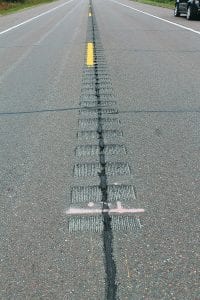About 40 citizens crowded into the county commissioners’ room at the courthouse at the beginning of the county board meeting on October 8, 2013 to talk to Minnesota Department of Transportation (MnDOT) District Engineer Duane Hill about rumble strips.
During the public comment period at the beginning of the meeting, Debra Vannet, one of many at the meeting who live along Highway 61 east of town where rumble strips were installed this summer, told the board that despite the fact that her brother, sister-in-law, and son were killed in car accidents, she opposed having centerline rumble strips along the entire North Shore corridor. She said rumble strips would not have saved their lives.
At every hour of every day, Vannet said, vehicles ranging from cars to 18-wheelers pass other vehicles along the straight stretch by Paradise Beach near her home. The noise can be heard two miles inland at times, debris hits her in the face when she exercises her dog along the shoulder, and when she drives over a rumble strip, she feels like her car might be thrown into the ditch. She said a family of eagles left its nest after the rumble strips went in.
Vannet said she recently took a trip out of state. One 85-mile stretch of highway had rumble strips down the middle, but she counted only seven homes or ranches along that stretch, and the rumble strips were narrower and shallower than the ones on Highway 61. A lot more people live along the North Shore, and tourists come here to find peace and quiet, she said.
Vannet said putting in more passing lanes would be a better use of highway funds than putting in rumble strips.
MnDOT’s rumble strip policy requires highways with shoulders wider than two feet to have both edge line and centerline rumble strips. No rumble strips are placed where driveways meet the road, but Commissioner Sue Hakes said many people have shared driveways, so the noise is still directly in front of people’s homes.
One resident said the number of highway deaths between Two Harbors and the border has been fairly low. He hoped MnDOT would consider removing rumble strips located near wayside rests and state parks on the North Shore. Another resident said that rumble strips east of town wouldn’t reduce accidents from people using their cell phones since that stretch of road has no cell phone service.
MnDOT’s response
MnDOT Engineer Duane Hill said he had already heard from a lot of the people in the room and had forwarded all the letters he received from both Cook and Lake County residents to the MnDOT Office of Traffic, Safety, & Technology. He apologized for the negative impacts the rumble strips had made on people’s lives but said that MnDOT decided in the spring of 2012 that all new MnDOT road projects would include the installation of rumble strips. “I hope to find a way to mitigate your concerns,” he said.
Engineer Hill said MnDOT is looking at rumble strip designs across the country. Over the next six months, they will be researching the noise and the options they have to deal with it. One study will target about 10 spots along the North Shore to determine how often the rumble strips are crossed and the amount of sound they create and compare that to other road noise. They will factor in the increased traffic they have measured during the busy season and will look at the effects of the topography and Lake Superior on the sound.
Another study outside the area will test a less noisy design to determine how effective it is in deterring cars from wandering into the wrong lanes. Hill said he hoped they would be able to install something that increases safety without decreasing quality of life, possibly even something that would alert drivers without sound. “I think this is a problem we can solve,” he said. They cannot, however, solve the problem of family members who come to them asking for safety improvements after losing loved ones to traffic accidents. “MnDOT is very committed to safety,” he said.
In the short-term, Hill said, MnDOT is looking at its open contracts to see if they can mitigate some of the noise as those projects are completed – hopefully by deer season—while they work out a longer-term plan. The district is holding off on about 100 miles of roadwork until they find a less noisy alternative to the rumble strips that have already been installed. He said he intended to send a letter to those who had contacted him once they come up with a plan and hoped he would hear from people after they mitigate the noise.
Engineer Hill said he hoped MnDOT can avoid being forced by legislation to change its policy. He said the Federal Highway Administration’s Towards Zero Death initiative has cut traffic fatalities in half.



Loading Comments